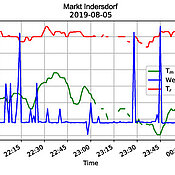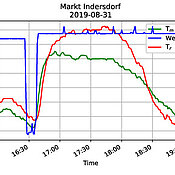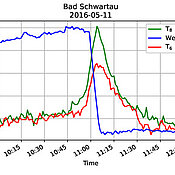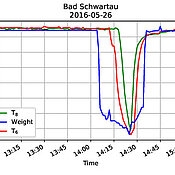Anomaly Detection in Beehives using Deep Recurrent Autoencoders
28.02.2020Our paper "Anomaly Detection in Beehives using Deep Recurrent Autoencoders" was accepted at SENSORNETS 2020.

All plants need pollination in order to reproduce. "Pollination is the transfer of pollen from a male part of a plant to a female part of a plant [...]" (Wikipedia), which enables the plant to fertilize and produce seeds. A small portion of pollination occurs by the wind, but a larger part is done by insects, such as (honey) bees. The decline in insects inhibits this way of pollination. To help apiarists monitor the health of their bee colonies, we developed an algorithm to detect anomalies (i.e. any abnormal behavior) within beehives. Within the we4bee project, we aim to support beekeepers in their decision making.
In our published paper Anomaly Detection in Beehives using Deep Recurrent Autoencoders1 we developed an algorithm, that can distinguish between normal sensor data from beehives and anomalous data. In a manual step, we are able to further classify different types of anomalies. For that we defined three types of anomalies typically occurring in beehives:
- Behavioral anomalies: This kind of anomaly describes any behavior of the bee colony. The most prominent anomaly of this type is swarming. Swarming is the event of a colony’s queen leaving the hive with a party of worker bees to start a new colony in a distant location. It is a naturally occurring, albeit highly stochastic reproduction process in a beehive. A second notable behavioral anomaly is mite infestation, which weakens the colony.
- Sensor anomalies: This kind of anomaly can be attributed to any device measuring the state of the colony, and can occur in any sensor network. Most common is the malfunction or defect of sensors.
- External interference: This kind of anomaly describes any force operating on the beehive externally. Any intervention by the beekeeper is an external interference.
Finding anomalies in large datasets requires specialized methods that extend beyond manual evaluations. Autoencoders (AEs) are a popular choice in anomaly detection. They are a deep neural network architecture, that is designed to reconstruct normal behavior with minimal loss of information (see Figure 1). In contrast, an AE’s reconstruction of anomalous behavior shows significant loss and can therefore be identified. They are purely data-driven without the need for beehive specific knowledge. This implies, the higher the difference in input and reconstructed input, the higher the evidence of an anomaly.
We evaluate our approach on three datasets: One long term dataset of four years provided by the HOBOS project, one short term dataset obtained from (Zacepins et al., 2016), and another short term dataset from we4bee. For this preliminary study, we focus on time spans where swarming can occur to show that our approach is working in general.
In future work we want to give apiarists even further insights into their colony by extending the current autoencoder. Additionally we include several sensors at once and continuously use a growing dataset to enhance performance. Furthermore we want to analyze the hibernation period, too. So, stay tuned for future updates into beehavior analysis in we4bee.
1: Davidson, P., Steininger, M., Lautenschlager, F., Kobs, K., Krause, A. & Hotho, A. (2020). Anomaly Detection in Beehives using Deep Recurrent Autoencoders. Proceedings of the 9th International Conference on Sensor Networks (SENSORNETS 2020) (p./pp. 142-149), : SCITEPRESS – Science and Technology Publications, Lda.. (Link)





